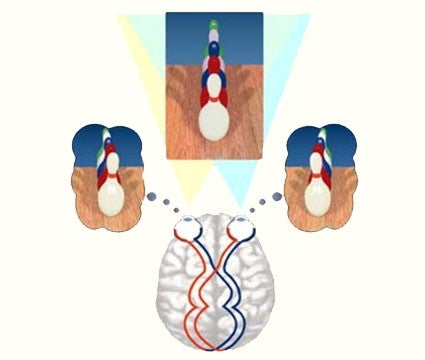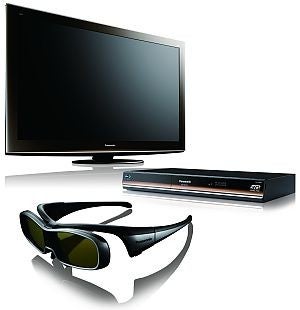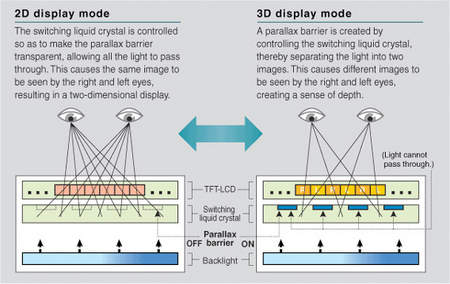3D: How does it work?

Currently, there areonly a few gadgets featuring glasses-free (also calledautostereoscopic) 3D displays. The LG Optimus 3D and theNintendo 3DS are probably the most popular ones and both use aspecial screen technology called parallax barrier. The 3DS evenallows for gradual control of just how much of a 3D effect you want.In addition, both of them (and a slew of recently announcedcamcorders) support recording in 3D via a dual-camera setup.

To understand the whole mechanism wehave to go back to the basics of human vision. We see theworld in 3D mostly because of our vision, which is similar to that 3Dcamera setup. Our left eye sees one thing and our right eye sees aslightly different picture. The eyes are spaced apart and each one ofthem takes a different stream of information from its own viewpoint.The brain mashes it all up in one beautifully deep 3D picture. That,of course, is aided by cues about depth from the shades and motion ofobjects. Similarly, the two camera sensors are placed at an inch orso of a distance and both simultaneously capture content, just likeyour eyes. The left camera records information for the left eye,while the right camera records its stream for the right eye. That'sexactly how the dual camera setup on the upcoming LG Optimus 3D andT-Mobile G-Slate works. From here on, the brain does its thing andvoila - you have 3D! But how do we then give each of the eye therespective video?
That's the magic of 3D. In the stone age of the 20th century it was simple – just get a pair of red/blue (cyan to be exact) glasses that say “geek” better than if you had it tattooed on your forehead. Those are called anaglyph and have the advantage of being the cheapest ones you can easily make from cellophane at home. The trickery relies on the two video streams edited to show one in red and the other in cyan. The glasses then act as filters – the red lens allows the “reds” stream and blocks the cyan one, while the cyan feeds only the cyans to the respective eye. The rest as you might have already guessed is brain work.
But then in the movie theaters, you watch something completely different. While we still have two streams of video, this time they are superimposed onto the screen using different filters. What you wear is polarized glasses, the reason is that they have differently polarized lenses. Usually, we have a vertical polarization on the one, allowing only the vertically polarized content to pass through, and a horizontal polarization on the other lens, which in turn gives you the horizontally polarized stream. Hence, each of the eyes sees a different picture and we're back to the brain doing the rest. In this case, though, you have a much better quality since no color information is lost as is the case with anaglyph (red/cyan) glasses. While polarized glasses themselves arerelatively cheap, your TV will need a screen with polarized coatingallowing each eye to see every other line, which comes at a highercost. The first TVs with the technology have already hit the market,but the price tag is pretty steep – prepare nearly $3500 for thefirst 65-inch Vizio Razor LED passive 3D TV.
Pros: Cheap, can be made at home, don't require special equipment
Cons: Some of the colors are lost, the effect is not that submersive
- Polarized glasses pros and cons
Pros: Better 3D effect, colors are represented more accurately, relatively affordable
Cons: Moving your head distorts the 3D effect with linear polarization, require special setup

And finally, some of you have (or mostprobably will have) 3D TVs at home, which require the fancy andrather expensive shutter glasses. The previous two types ofglasses are known as passive since they don't need a power source(and that much of an investment as the shutter glasses!), but theshutter glasses come with a battery. The shutter lenses are actuallysmall LCD screens that alternate the picture for each of the eye atrapid speed. To achieve this they simply dim and turn back on inthe blink of an eye. At the same time, your 3D TV first shows thestream for the left eye while the right lens dims the picture for theright eye, then the stream for the right eye appears, while the leftlens is dimmed. This alternation happens at a rate of about 120 timesper second. The shutter glasses on theirpart are usually synchronized with the TV via infrared or RF. Thisallows each of the eyes to get the corresponding picture and pass itto the brain for achieving the effect of depth. You might wonder whathappens to the frame rate and rightfully so. The consecutiveswitching between two streams cuts it in half and this is why youmight sometimes see jittery video on your 3D TV.
Pros: Unmatched quality
Cons: Frame rate drops, Full HD support limited to TV sets with higher processing speeds (like Plasma TVs)
Glasses-free (autostereoscopic) 3D - "very nice, how much?"
But with all this said, how does the filtering of the two recorded video streams happen without the glasses?

- Parallax barrier glasses-free 3D pros and cons
Pros: No glasses required!
Cons: 3D effect strongly dependent on angle, distance













Things that are NOT allowed: